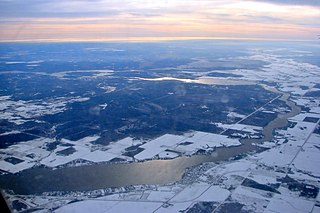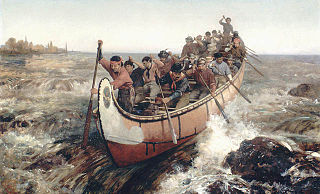Related Research Articles

The Hudson's Bay Company is a Canadian retail business group. A fur trading business for much of its existence, it became the largest and oldest corporation in Canada, and now owns and operates retail stores across the country. The company's namesake business division is Hudson's Bay, commonly referred to as The Bay.

The North West Company was a fur trading business headquartered in Montreal from 1779 to 1821. It competed with increasing success against the Hudson's Bay Company in the regions that later became Western Canada and Northwestern Ontario. With great wealth at stake, tensions between the companies increased to the point where several minor armed skirmishes broke out, and the two companies were forced by the British government to merge.

The Rainy River is a river, approximately 137 miles (220 km) long, forming part of the Canada–United States border separating Northwestern Ontario and northern Minnesota.

Winnipeg River is a Canadian river that flows roughly northwest from Lake of the Woods in the province of Ontario to Lake Winnipeg in Manitoba. This river is 235 kilometres (146 mi) long from the Norman Dam in Kenora to its mouth at Lake Winnipeg. Its watershed is 106,500 square kilometres (41,100 sq mi) in area, mainly in Canada. About 29,000 square kilometres (11,000 sq mi) of the watershed is in northern Minnesota, United States.

Grand Portage National Monument is a United States National Monument located on the north shore of Lake Superior in northeastern Minnesota that preserves a vital center of fur trade activity and Anishinaabeg Ojibwe heritage. The area became one of the British Empire's four main fur trading centers in North America, along with Fort Niagara, Fort Detroit, and Michilimackinac.

Fur brigades were convoys of canoes and boats used to transport supplies, trading goods and furs in the North American fur trade industry. Much of it consisted of native fur trappers, most of whom were Métis, and fur traders who traveled between their home trading posts and a larger Hudson's Bay Company or Northwest Company post in order to supply the inland post with goods and supply the coastal post with furs.

The North West Company is a multinational Canadian grocery and retail company which operates stores in Canada's western provinces and northern territories, as well as the US states of Alaska, Hawaii, and several other countries and US territories in Oceania and the Caribbean.

Fort Saint Pierre on Rainy Lake was the first French fort built west of Lake Superior. It was the first of eight forts built during the elder Vérendrye's expansion of trade and exploration westward from the Great Lakes.

Bas de la Rivière is a geographical area on both sides of the Winnipeg River at and near the mouth where it empties into Lake Winnipeg. It had a storied historical period in the opening of the west and the subsequent fur trade and settlement.

This article covers the water based Canadian canoe routes used by early explorers of Canada with special emphasis on the fur trade.

Revillon Frères was a French fur and luxury goods company, founded in Paris in 1723. Then called la Maison Givelet, it was purchased by Louis-Victor Revillon in 1839 and soon, as Revillon Frères, became the largest fur company in France. Branches were opened in London in 1869 and in New York in 1878. At the end of the 19th century, Revillon had stores in Paris, London, New York City, and Montreal.
Fort Lac la Pluie was a fur trade depot established by the North West Company sometime between 1775 and 1787. It was located on a high bank on the west side of modern Fort Frances, Ontario across from International Falls, Minnesota on the Rainy River downstream (west) of some rapids where the river flows out of Rainy Lake. Upstream at the outlet of the lake was the old French post of Fort Saint Pierre (1731-1758). The site is marked by a granite boulder. Morton describes some runnable rapids, Fort Saint Pierre and a fall that had to be portaged before reaching the fort, which implies that the river level may have changed.
Hungry Hall was the name of two unrelated Canadian trading posts.
Louis Primeau or Primo was one of the first European fur traders on the Churchill River. Primeau Lake in northern Saskatchewan, Canada is named after him. Little is known of his youth. Morton says that he was born in Quebec of an English father and French mother, but the DCB does not repeat this.
Pedlar is a term used in Canadian history to refer to English-speaking independent fur traders from Montreal who competed with the Hudson's Bay Company in western Canada from about 1770 to 1803. After 1779 they were mostly absorbed by the North West Company. The name was first used by the Hudson's Bay Company to refer to French coureurs des bois, who travelled inland to trade with the Indians in their villages and camps. This was in contrast to the HBC policy of building posts on Hudson Bay, to where the Indians would bring furs to trade with them.
Fur trading on the Assiniboine River and the general area west of Lake Winnipeg, in what is now Manitoba, Canada, began as early as 1731.

The Pemmican War was a series of armed confrontations during the North American fur trade between the Hudson's Bay Company (HBC) and the North West Company (NWC) in the years following the establishment of the Red River Colony in 1812 by Lord Selkirk. It ended in 1821 when the NWC merged with the HBC.

Fort Albany was a Hudson's Bay Company trading post established in 1679 near the site of the present day Fort Albany First Nation. The fort was one of the oldest and most important of the Hudson's Bay Company's posts. It was also involved in Anglo-French tensions leading to the Battle of Fort Albany in 1688.
References
- ↑ Manitoba archives below